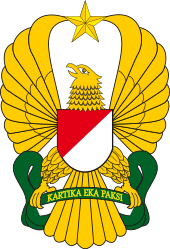Kopassus
The Special Forces Command (Indonesian: Komando Pasukan Khusus is an Indonesian Army (TNI-AD) special forces group that conducts special operations missions for the Indonesian government, such as direct action, unconventional warfare, sabotage, counter-insurgency, counter-terrorism, intelligence gathering and Special reconnaissance (SR). Kopassus was founded on 16 April 1952. It gained worldwide attention after several operations such as the Indonesian invasion of East Timor and the release of hostages from Garuda Indonesia Flight 206.
| Special Forces Command | |
|---|---|
| Komando Pasukan Khusus / Kopassus | |
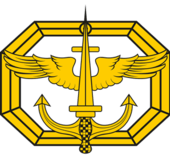 Insignia of Kopassus. | |
| Active | 16 April 1952 — present |
| Country | |
| Branch | |
| Type | Special Operation Forces |
| Role |
Secondary roles:
|
| Size | Division (4 brigades and 1 training center) |
| Part of | |
| Garrison/HQ | Cijantung |
| Nickname(s) | Hantu Rimba (Ghost of the Jungle), Baret Merah (Red Berets), Komando |
| Motto(s) | Berani, Benar, dan Berhasil (English: Brave, Rightful, and Successful) |
| Engagements |
|
| Commanders | |
| Current commander | Major General I Nyoman Cantiasa |
| Notable commanders |
|
The Special Forces spearheaded some of the government's military campaigns: putting down regional rebellions in the late 1950s, the Operation Trikora (Western New Guinea campaign) in 1961–1962, the Indonesia-Malaysia Confrontation from 1962–1966, the massacres of alleged communists in 1965, the East Timor invasion in 1975, and subsequent campaigns against separatists in various provinces.
Kopassus is reported by national and international media, human rights-affiliated NGOs and researchers[1] to have committed violations of human rights in East Timor, Aceh, Riau and Papua and the capital Jakarta. Published articles in mainstream media may include epithets such as "the notorious Kopassus" or "abusive Indonesian unit".[2][3]
History
On 15 April 1952, Colonel Alexander Evert Kawilarang began to form Kesatuan Komando Tentara Territorium III/Siliwangi (Kesko TT), the early name of Kopassus and the basis for this historic special forces unit.
Not long after, Colonel Kawilarang with the use of military intelligence located and met with Major Rokus Bernardus Visser—a former member of the Dutch Special Forces who had remained in newly independent Indonesia, settled in West Java, married an Indonesian woman, and was known locally as Mochammad Idjon Djanbi. He was the first recruit for the Indonesian special forces, as well as its first commander. Due to him, the unit which later became Kopassus wear red berets (color traditionally favored by airborne troops in Europe) instead of the distinctive green beret.[4]
At that time, Indonesia's special force name was 3rd Territorial Army Command Commando Unit (Indonesian: Kesatuan Komando Teritorium Tiga (Kesko TT)). Kopassus was the final result of five name changes: KTT, KKAD (KK Angkatan Darat, Army Commando Forces Unit), RPKAD, Puspassus (Army Special Forces Department) and Kopassandha.[5] The first generation of this force was only around a hundred soldiers or one company, headquartered in Bandung. Among its pioneer instructors was a young veteran of the Indonesian National Revolution, future Minister of Defense Leonardus Benjamin Moerdani, who later became a battalion commander and later led his paratroopers to crush the two twin rebellions in 1957-58 by the Revolutionary Government of the Republic of Indonesia and Permesta.
As the RPKAD (Resimen Para Komando Angkatan Darat, Army Para-Commando Regiment),a name used in the 1960s, and expanded into a three-battalion special forces airborne regiment, the para-military force was involved in the widespread killings[6] during Gen. Suharto's rise to power. An estimated half-a million people were killed in the anti-communist purge with strong communal overtones.
The RPKAD was involved in wiping out entire villages such as Kesiman (east of Denpasar) in Bali, many of them in beach areas which later becomes major tourist resorts.[7]
The unit also saw action during the Indonesia-Malaysia Confrontation when in 1965, Indonesia launched a war for control of North Borneo (Sabah/Sarawak) during Malaysian independence, particularly in the Battle of Sungei Koemba. In 1981, with Moerdani yet again at the lead, a Kopassandha company was deployed to Bangkok as part of the efforts to rescue Garuda Indonesia Flight 206 from hijackers.
In 2017 Kopassus was sent to Afghanistan to guard the Indonesia embassy in Kabul, Afghanistan.[8][9]
Organization
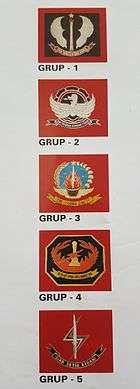
Kopassus organizational structure is different from the infantry units in general. Although Kopassus members generally came from the Infantry Corps, Kopassus created its own structure, which is different from infantry units.
Kopassus units intentionally do not use the nomenclature of standard infantry units. This is apparent in their units called Groups. With this unit, Kopassus can deploy a brigade plus size (about 5,000 personnel), or fewer.
There are Five (5) groups of Kopassus which are:
- Special Forces Training and Education Center ("Pusdikpassus") - located in Batujajar, West Java
- 1st Para Commandos Group
- 2nd Para Commandos Group
- Group 3 Sandi Yudha (Clandestine)
- SAT-81 Gultor Counter-terrorism Group
Except for Pusdikpassus, which serves as an educational center, other Groups have combat oriented operational functions. Each Group (except Pusdikpassus) is subdivided into battalions, for example: Yon 11, 12, 13 and 14 (from Group 1), and Yon 21, 22 and 23 (from Group 2).
Group 1 Para Commandos
.jpg)

Group 1 Para Commando ("GRUP 1 PARA KOMANDO") is a unit of Brigade level which is part of the Army Special Forces Command and was established on 23 March 1963. The group was first commanded by Major L.B. Moerdani. The unit's motto known as Dhuaja is Eka Wastu Baladhika,[10] then created by Corporal Suyanto. It has a total of 3,274 personnel.[11] The unit's internal organization consists of the group headquarters and four battalions which are:
- 11th Battalion / "Atulo Sena Bhaladhika"
- 12th Battalion / "Asabha Sena Baladhika"
- 13th Battalion / "Thikkaviro Sena Bhaladhika"
- 14th Battalion / "Bhadrika Sena Bhaladhika"
Each battalion consists of 3 companies. Each company is broken into 3 platoons, each of which consisted of 39 people. And each platoon consists of 3 small units called a squad of 10 men. The 1st Group, with its 4 battalions, is the largest brigade of the Kopassus.
Group 2 Para Commandos
Group 2 Para Commando ("GRUP 2 PARA KOMANDO") is a unit of Brigade level, which is part of the Special Forces Command of the Army and was established in 1962. The group was first commanded by Major Soegiarto. The unit's motto is Dwi Dharma Bhirawa Yudha and has a total of 1.459 personnel. The unit's internal organization are as follows:
- Group HQ
- 21st Battalion / "Buhpala Yudha"
- 22nd Battalion / "Manggala Yudha"
- 23rd Battalion / "Dhanuja Yudha" - located in Parung, Bogor
Like "Group 1", "Group 2" has the main tasks and responsibilities for missions such as Airborne assault, Jungle warfare, Unconventional Warfare, Counter-Insurgency, Special Reconnaissance, and Direct Action.
Special Forces Training and Education Center
The Special Forces Training and Education Center or SFTEC (Pusat Pendidikan dan Latihan Pasukan Khusus) abbreviated "Pusdiklatpassus" is the training and education center for recruits and personnel associated with and becoming to join as Commandos in the Army Special Forces Command (Kopassus). As an educational institution, "Pusdiklatpassus" is divided based on its training function. Supervises nine schools of education and training including:
- Para School
- Commando School
- Sandhi Yudha (Intelligence) School
- School of Specialized Warfare
- Specialization School
- Raider School
It provides other specialist courses, which are also open to members of the Army out of Kopassus such as: Hunting Company, Scuba, Rock-climbing, Demolition, Path-Finder and Sniper.
Commando Training
.jpg)
The Commando education and training lasts for approximately seven months (28 weeks) which is divided into three stages. The first phase of the implementation of the education is conducted on the base for 18 weeks, the second stage all participants will be released in the forest and the mountains twice each for 6 weeks, and the next stage of the third stage ends with a 4-week sea-swamp stage. The 97th batch of the Commando Education had first initial participants as many as 251 personnel, who successfully passed through commando education and inaugurated as a special forces commando of 214 personnel. Phases are as shown below:
- Phase I (Base training)
10 Weeks with individual ability points in Batujajar. Establish attitudes & personality, fill in technical skills, Command Operation tactics, Individual & basic capabilities of urban battle, Support knowledge, Field managerial, and individual ability test.
- Phase II (Forest and Mountain)
6 Weeks with GLG emphasis, Jungle warfare and Raid warfare in Situ Lembang. Stabilization of forest observations, individual abilities in the forest / Basic battle techniques, forest capabilities in group relations, forest HTF, and durability of long march application (PPJJ).
- Phase III (Swamp and Sea)
4 Weeks with heavy Commando operation tactics, sea battle tactics in Cilacap and Nusakambangan. Conservation observation of Sea-swamp, patrol ability, swamp terrain knowledge and CAMP endurance test.
"Kopassus" has graduated students from the Commando Education (Dikko) up to 100 batches. In the year 2016 followed by 153 commando students, which consists of ranks of 41 Officers, 101 NCOs, and 11 Enlisted. The command officers who successfully complete the 7-month Command Course well are entitled to wear the qualified commando brevet issued to their clothing/uniform.
Aside from Kopassus commandos, the SFTEC also trains SF-ready combat personnel of the Army Raider Infantry battalions within the structure of the territorial region commands or KODAMs Army-wide and within Kostrad compotent units.
Group 3 Combat Intelligence
Group 3 / Sandhi Yudha is a Kopassus unit that has the specification of "Clandestine operation" 'secret warfare', including combat Intel and counter-insurgency. Group 3 was formed on 24 July 1967, headquartered at Cijantung Kopassus Headquarters, East Jakarta. Prospective Personnel in this Group are strictly selected internally ranging from prospective soldiers who are still educated to personnel who have active duty in unity but have an intelligence talent that will then be trained again. The motto of this unit is "Chatur Kottaman Wira Naraca Byuha". The Group is organized as follows:
- Group HQ
- 31st Battalion/Eka Sandhi Yudha Utama
- 32nd Battalion/Apta Sandhi Prayudha Utama
- 33rd Battalion/Wira Sandhi Yudha Sakti
Conducted Training
The basic training is the same as other Kopassus soldiers (2.5 months), Command School (7 months) plus other courses such as PH (Jungle Warfare), PJD (Close Combat), Spursus (Special combat school )and Dakibu (Climber,) but after that the candidates of combat-intelligence is educated more specifically for the education of "Sandhi Yudha" in "Pusdiklatassus" located in Batujajar whose education materials are intelligence and supporting knowledge for intelligence in the field of operation such as disguise, navigation, special martial, Special tools of intelligence and others. Even some selected personnel from this Group are sent abroad to schools of Military Intelligence Education Centers such as in the United States, Germany, Britain and even Israel. Among all types of soldiers in "Kopassus", the most specific form of education and training is the Group 3 / Sandhi Yudha combat intelligence unit.
SAT-81 Gultor Counter-terrorism group
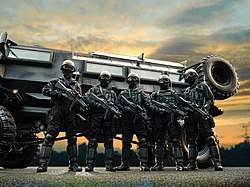
Unit 81 / Counter Terror or abbreviated as Sat-81 / Gultor is a unit in Kopassus which is equvalent to a group level formation and is composed of the best chosen personnel within the whole of the Indonesian Army special forces. The strength of this unit is not publicly publicized on the number of personnel or types of weapons. The Sat 81 gultor is incorporated in the BNPT Crisis Control Center ("Pusdalsis") which consists of a combination of special units, such as the Denjaka from the Indonesian Navy, the Bravo Detachment 90 of the Indonesian Air Force, and the 1st Gegana Command of the Brimob Corps, Indonesian National Police. "Pusdalsis" is organized of a combination of elite units within the Indonesian National Armed Forces and Police which is assigned as a counter-terrorist formation to be sent when the activities of terrorism may be conducted such as aircraft hijacking. Special Battalions under this unit are:
- Special Action Battalion / Wega Yogya Gabhira
- Assistance Battalion / Wira Drdha Ghabira
Recruitment is done by choosing from members which at least have 2 years of active service in the groups of the Kopassus organization.
Command Structure
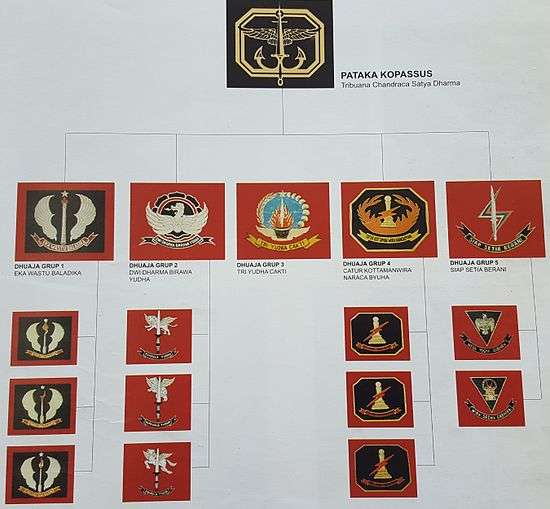
Training
Kopassus participates in bilateral training exercises with international partners. After resuming military ties in 2003, Australia's special operations unit, the Special Air Service Regiment, conducts an annual counter terrorism exercise, with Australia and Indonesia taking turns to host the event.[12]
In July 2011, Kopassus and Chinese special forces held a joint counter terrorism exercise called Exercise Sharp Knife, held in Bandung, Java.[13] In 2012, the same exercise was held in Jinan, Shandong province, in July.[14]
In 2015,Kopassus and South Korea 707th Special Mission Battalion held a joint counter terorrism exercise in South Korea.
On 19 February 2018,Kopassus and 9th Para (Special Forces) held a joint exercise called Garuda Sakti in Cipatat, Bandung.
On 7 February 2019,Kopassus and Special Service Group held a joint counter terorrism exercise called Elang Strike in Pabbi, Pakistan.
Former Secretary of Defense Ryamizard Ryacudu and Acting Secretary of the Defense Secretary of the United States or Acting Secretary of Defense of the US, H.E.Patrick M. Shanahan. agreed to conduct joint combat medic training between united state special forces and Kopassuss unit 81 in 2020
Uniform and Attributes
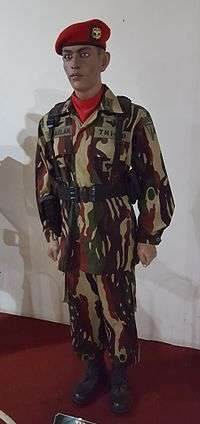
Brief History of Kopassus Attributes
The Kopassus (then RPKAD) red beret was first used in 1954-1968 and was designed by Lieutenant Dodo Sukamto. It was first used during a ceremony on 5 October 1954. This emblem consists of a bayonet, anchors representing abilities in the sea and wings as high mobility. The beret emblem used in 1968 until now with slight changes from the initial design, the bayonet is more slender than the Commando knife and the wingspan is more wing coat like the Wing of the Army designs. The iconic Kopassus Camouflage pattern called Loreng Darah Mengalir (Flowing Blood pattern), introduced in 1964 pattern was originally intended to be a copy of the WW2 era British Denison brushstroke camouflage for issue to the RPKAD. However, an error at the original manufacturing plant resulted in the vertical, vine-like stripes that characterize this unique pattern.The original version illustrated, with some variation in color and type of fabric, saw service between 1964 and 1986 (at which time the entire Armed Forces were outfitted in a copy of British DPM). The second pattern shown was revived for issue to Kopassus in 1995 but in a slightly varied design, worn for ceremonial & training purposes only. For other purpose regular TNI patern (DPM) was used instead.
Commando Brevet
The Commando qualification brevet used since 1966 until now was designed by Major Djajadiningrat. This brevet is used by all graduates of Commando training and Education from Batujajar. Colonel Sarwo Edhie Wibowo in a demonstration of "Show Of Force" at Senayan's parking lot on 4 January 1966 used the new Commando Brevet qualification to show the public of the Corps' new appearance.
Paratrooper Badges
Jump Master Wings
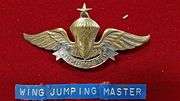
Jump Master Wings are issued to commandos of Kopassus who have graduated from advanced paratrooper jump master courses conducted by the Commando training and educational center.
Free Fall Wing
The Kopassus (RPKAD) military freefall wing insignia, designed by HH.Djajadiningrat and first issued in 1962 depicts a free fall paratrooper hanging under a circle consisting of small parachutes. Stated by the first free fall instructors of the Yugoslavia: Mladen Milicetic, Stoyan Jovic and Dobel Stanej in Bandung during the first free fall graduation ceremony of Kopassus (RPKAD) on 26 October 1962.[15]
Human rights
Kopassus has been accused by NGOs, Western politicians, and researchers of human rights violations.[1] Amnesty International and Indonesian human rights groups including the official National Commission on Human Rights (Komnas HAM) have cited abuses by members of Kopassus.
Kopassus has also been associated with illegal economic activities, like involvement in the trade of Agarwood and illegal gold mining in West Papua and other areas, and the trade in drugs.[2]
In 1975, five Australian journalists, known as the Balibo Five, were killed by members of Kopassus in the town of Balibo during the Indonesian invasion of East Timor.[16] The Indonesian military has always maintained that the men were killed in a cross-fire during the battle for the town.[17]
During the May 1998 riots of Indonesia, Kopassus members were involved in organising and carrying out acts of murder and violence against Chinese Indonesians.[18] This included involvement in mass gang-rapes of Sino-Indonesian women and girls across Jakarta.[19] Kopassus has also been considered responsible for the 1997–98 activists kidnappings in Indonesia. According to the Federation of American Scientists, a number of activists were kidnapped by KOPASSUS troops in the last months of the Suharto regime, and at least 23 government critics disappeared.[20]
In 2001, four Kopassus members were convicted of the strangulation of Theys Eluay, the former chairman of the Papua Presidium Council. They were part of a group which had killed Theys after ambushing him and his driver. The group's leader, Lt-Col Hatono, and another soldier received prison sentences of three and a half years while two others received three years. A further two officers had their charges dismissed.[21] The men were all Kopassus members from Group V (Jakarta) and were not based in Jayapura or West Papua. They faced a court-martial, which found them not guilty on the more serious charges of premeditated murder, because the Kopassus are legally exempt from the jurisdiction of civil law. Indonesian Army Chief, General Ryamizard Ryacudu (2002–05), accepted the men had to be prosecuted "because Indonesia is a State based on law" but he affirmed their defence's view that they were heroes who had killed a rebel leader.[22]
Some international partners have severed military ties with Kopassus in response to allegations of human rights abuses. For example, Australia ceased training with Kopassus in 1999 in relation to Kopassus' role in violence in East Timor.[23]
Criminal conduct
In September 2015, General Mulyono, the Army chief of staff, stated that "There are still soldiers from the Indonesian Army who taint the name of their force and the Army with their arrogant and selfish attitudes by engaging in misdeeds or even acting against the law", which according to the Jakarta Globe newspaper was a reference to actions by Kopassus members.[24] Examples include:
- 23 March 2013: Kopassus soldiers forcibly entered Cebongan Prison, near Yogyakarta, and killed four prisoners awaiting trial for the stabbing of a Kopassus soldier in a cafe.[25]
- 1 June 2015: Seven Kopassus members were charged for attacking a group of Indonesian Air Force officers, resulting in the death of one person.[26]
- July 2015: A Kopassus member was arrested for his suspected involvement in the kidnapping of a Malaysian businessman.[27]
Equipment
Small arms
|
|
Fighting vehicles
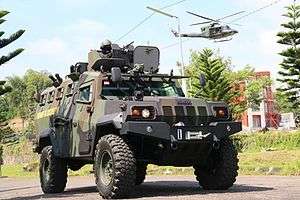
Notable members
- Mochammad Idjon Djanbi - First Kopassus Commander
- Alexander Evert Kawilarang - Founding father of Kopassus
- Feisal Tanjung
- Sarwo Edhie Wibowo
- Sanurip
- LB Moerdani - Former Commander of the Indonesian National Armed Forces and former Minister of Defence.
- Yogie SM (id) - Former Minister of Home Affairs and Governor of West Java
- Wismoyo Arismunandar (id) - Former Chief of Staff of the Army
- Agum Gumelar - Politician, former Minister of Transportation, former Minister of Defence and former Head of Football Association of Indonesia
- Prabowo Subianto - Politician, minister of Defense in Joko Widodo's government since 2019
- Sutiyoso - Politician, former Governor of Jakarta and head of Indonesian State Intelligence Agency
- Luhut Binsar Pandjaitan - Politician, coordinating minister of maritime affairs in Joko Widodo's government since 2016
- Colonel Mung Parhadimuljo
- General Meas Sophea (honorary member) chief of the Royal Cambodian Army.
- Ibrahim Ismail of Johor (honorary member) during became Crown Prince Johor in early 1990s
Kopassus in popular culture
- Pengkhianatan G30S/PKI, A 1984 Indonesian docudrama written and directed by Arifin C. Noer, produced by G. Dwipayana, and starring Amoroso Katamsi, Umar Kayam, and Syubah Asa. The film was based on an official history of the 30 September Movement (Gerakan 30 September, or G30S) coup in 1965 written by Nugroho Notosusanto and Ismail Saleh, which depicted the coup as being orchestrated by the Communist Party of Indonesia (Partai Komunis Indonesia, or PKI).[34]
- Merah Putih Memanggil, A 2017 Indonesian movie directed by Mirwan Suwarso and starring Maruli Tumpubolon. The film depicted hostage rescue situation.[35]
- Patriot, mini-series in Net TV in 2016 starring Rizky Hanggono about a group commando liberation village.[36]
See also
- Kostrad
- Denjaka
- Kopaska
- Paskhas
- Garda Muda Penegak Integrasi, an Indonesian paramilitary group
References
Notations
- Ken Conboy (2003) KOPASSUS Inside Indonesia's Special Forces, Equinox Publishing, ISBN 979-95898-8-6
Notes
- Tanter, Richard; van Klinken, Geert Arend; Van Klinken,Gerry; Ball, Desmond (2006). Masters of terror: Indonesia's military and violence in East Timor. Lanham MD: Rowman & Littlefield. p. 218.CS1 maint: uses authors parameter (link)
- Jones, Tony; Griffiths, Emma (12 August 2003) "Al Qaeda claim could be authentic: Howard". (transcript) Lateline, Australian Broadcasting Corporation (ABC). Retrieved 12 July 2013
- McBeth, John (14 June 2019). "Abusive Indonesian unit back in America's good graces". Asia Times. Retrieved 15 January 2020.
- "Kopassus: Inside Indonesia's Special Forces"
- Komando Pasukan Sandi Yudha; Sandhi Yudha roughly translated as "secret or covert warrior", translated as Special Forces Corps.
- Robert Cribb. Southeast Asia: a historical encyclopedia, v. 3, ed. Keat Gin Ooi, article on Gestapu Affair (1965).
- Prashad, Vijay (2009). The Darker Nations : A Biography of the Short-Lived Third World. LeftWord Books. p. 167
- https://en.antaranews.com/news/113959/indonesia-to-deploy-military-personnel-at-its-embassy-in-kabul&sa=U&ved=2ahUKEwik6PjIqIjrAhWEbn0KHfAvCg4QFjAAegQIARAB&usg=AOvVaw14RLQ4FYXHLMqOycAd3De7
- http://www.asianews.eu/content/indonesia-send-troops-kabul-mission-63617&sa=U&ved=2ahUKEwjGvdXDp4jrAhUZcCsKHUpwD7YQFjARegQIAxAB&usg=AOvVaw2UtgDMvoCEzZPRDPFOCDWp
- "Profil Grup 1 Kopassus Serang - HobbyMiliter.com". HobbyMiliter.com. 22 April 2016. Retrieved 8 June 2017.
- COMMANDO Magazine, Volume II No. 1 July–August 2005. Jakarta: Gramedia, 2005.
- Desy Nurhayati (28 September 2010) "Kopassus, Australia's SAS conduct joint anti-terrorism drill". The Jakarta Post. Retrieved 12 July 2013
- Luke, Leighton G. (15 June 2011) "China, Indonesia Launch Joint Special Forces Training Initiative". futuredirections.org.au. Retrieved 12 July 2013
- Zhao Wei (2 July 2012) "China, Indonesia hold joint anti-terrorism exercise". english.sina.com, Retrieved 12 July 2013
- https://muhammadsubchi.wordpress.com/2011/04/10/kopassus-6-atribut-kopassus-pendidikan-komando-rekrutmen/
- McDonald, Hamish (16 November 2007). "Balibo Five deliberately killed: coroner". The Sydney Morning Herald.
- "The Balibo five: Among so many dead in East Timor, a few now famous foreigners". The Economist. 27 August 2009. Retrieved 16 October 2013.
- "Ethnic Chinese tell of mass rapes". BBC NEWS. 23 June 1998. Retrieved 16 October 2013.
- "The May 1998 Riot in Jakarta, Indonesia". http://www.esri.com. Retrieved 16 October 2013. External link in
|publisher=(help) - https://fas.org/irp/world/indonesia/kopassus.htm
- Moore, Matthew & Karuni Rompies (22 April 2003). Kopassus guilty of Eluay murder. The Age. Retrieved 12 July 2012.
- Kingsbury, Damien (2003). Power Politics and the Indonesian military. Routledge. p. 280. ISBN 0-415-29729-X.
- Damien Kingsbury, March 2004 "Australia's Renewal of Training Links With KOPASSUS: A Critique". Strategic and Defence Studies Centre, Research School of Pacific and Asian Studies, Australian National University, Retrieved 12 July 2012
- Wardhy, Robertus (25 September 2015). "Army Chief Calls on Kopassus to Dial Back Its Misconduct". Archived from the original on 28 October 2015. Retrieved 4 November 2015.
- "Indonesian Army Admits Kopassus Members Gunned Down Sleman Jail Detainees". 4 April 2013. Retrieved 4 November 2015.
- Susanto, Ari (5 June 2015). "Seven Soldiers Charged Over Fatal Brawl at Yogya Cafe". Retrieved 4 November 2015.
- "Two TNI Soldiers Among Seven Arrested for Alleged Abduction of Malaysian Businessman". 27 July 2015. Retrieved 4 November 2015.
- "Kopassus & Kopaska - Specijalne Postrojbe Republike Indonezije" (in Indonesian). Hrvatski Vojnik Magazine. Archived from the original on 28 October 2012. Retrieved 18 October 2009.
- "Komando Pasukan Khusus (Kopassus)". ShadowSpear Special Operations News. 28 January 2009. Archived from the original on 11 February 2010. Retrieved 18 October 2009.
- "Senjata SS2 V5C Kopassus". 24 June 2012.
- "Archived copy". Archived from the original on 28 October 2012. Retrieved 12 June 2010.CS1 maint: archived copy as title (link)
- http://garudamiliter.blogspot.com/2012/04/casspir-mk3.html
- "Komodo Untuk Pasukan Khusus". 27 April 2013.
- Pengkhianatan G30S/PKI on IMDb
- Merah Putih Memanggil on IMDb
- Budiman, Hary Ganjar (March 2018). "Representasi Tentara dan Relasi Sipil-Militer Dalam Serial Patriot" [The Representation of Army and Civil-Military Relations In Patriot Series]. Jurnal Patanjala (in Indonesian). 10 (1): 115–130.
External links
- Kopassus official website
- (in Indonesian) Mabes TNI-AD: Kopassus
- Specialoperations.com report
- Specwarnet.com report
- Globalsecurity.org report
- "South African mercenaries helped KOPASSUS", by Peter Cronau, Pacific Journalism Review
- Background on Kopassus and Brimob
- Indonesian Forces Tapped by Obama for Renewed US Aid Implicated in New Assassinations - video report by Democracy Now!
- Photos
